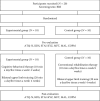Effects of Combining Cognitive Behavioral Therapy with Bilateral Upper Limb Training in Stroke Patients: A Randomized Controlled Trial
- PMID: 35912312
- PMCID: PMC9282985
- DOI: 10.1155/2022/4688113
Effects of Combining Cognitive Behavioral Therapy with Bilateral Upper Limb Training in Stroke Patients: A Randomized Controlled Trial
Abstract
CBT has a beneficial effect on depression and anxiety; however, the number of cases where therapy was used in patients with stroke was rare. In addition, there is still a lack of research on the effects of occupation-based training and the effects of bilateral upper limb training that provides an intervention based on patients' state of hemiplegic upper limb function. This study investigated the effects of combining CBT and occupation-based bilateral upper limb training on the depression, anxiety, upper limb function, and occupational performance. The experimental group was given 30-min cognitive behavioral therapy and occupation-based bilateral upper limb training, while the control group was given 30-min conventional occupational therapy and occupation-based bilateral upper limb training. For both groups, the intervention was given as a 30-min session once a day and five times a week for 4 weeks. Following intervention, the experimental group showed significant within-group variance for automatic thoughts, depression, anxiety, upper limb function, and occupational performance only (p < 0.01). For between-group variance, a significant difference was found for automatic thoughts, depression, anxiety, and occupational performance (p < 0.01), however, not for upper limb function (p > 0.05). In this study, it is meaningful that this author provided good guidelines for therapists and caregivers by organizing and providing actual programs in a very rare situation where cognitive behavioral therapy was applied to stroke patients.
Copyright © 2022 SoEun Choi and DeokJu Kim.
Conflict of interest statement
The author declares no conflicts of interest.
Figures
Similar articles
-
The Effect of Occupation-Based Bilateral Upper Extremity Training in a Medical Setting for Stroke Patients: A Single-Blinded, Pilot Randomized Controlled Trial.J Stroke Cerebrovasc Dis. 2019 Dec;28(12):104335. doi: 10.1016/j.jstrokecerebrovasdis.2019.104335. Epub 2019 Sep 30. J Stroke Cerebrovasc Dis. 2019. PMID: 31582271 Clinical Trial.
-
Effectiveness of Bilateral Arm Training for Improving Extremity Function and Activities of Daily Living Performance in Hemiplegic Patients.J Stroke Cerebrovasc Dis. 2017 May;26(5):1020-1025. doi: 10.1016/j.jstrokecerebrovasdis.2016.12.008. Epub 2017 Feb 2. J Stroke Cerebrovasc Dis. 2017. PMID: 28162905 Clinical Trial.
-
Functional rehabilitation of upper limb apraxia in poststroke patients: study protocol for a randomized controlled trial.Trials. 2015 Nov 5;16:508. doi: 10.1186/s13063-015-1034-1. Trials. 2015. PMID: 26542104 Free PMC article. Clinical Trial.
-
The Effects of Unilateral Versus Bilateral Motor Training on Upper Limb Function in Adults with Chronic Stroke: A Systematic Review.J Stroke Cerebrovasc Dis. 2021 Apr;30(4):105617. doi: 10.1016/j.jstrokecerebrovasdis.2021.105617. Epub 2021 Jan 27. J Stroke Cerebrovasc Dis. 2021. PMID: 33516068
-
A review of bilateral training for upper extremity hemiparesis.Occup Ther Int. 2009;16(3-4):190-203. doi: 10.1002/oti.277. Occup Ther Int. 2009. PMID: 19517519 Review.
Cited by
-
Stroke patients' knowledge, attitudes, and practices regarding home-based exercise and psychological rehabilitation programs.Front Med (Lausanne). 2025 Jun 26;12:1598489. doi: 10.3389/fmed.2025.1598489. eCollection 2025. Front Med (Lausanne). 2025. PMID: 40641977 Free PMC article.
References
-
- Harvey R. L., Roth E. J., Yu D. Physical Medicine & Rehabilitation . Saunders Elsevier; 2007. Rehabilitation in stroke syndromes.
-
- Kim W. O., Kang H. S., Wang M. J., Kim J. H., Choi J. Y. Relationships among activity of daily living, depression, and quality of life (QOL) in patients with stroke. Journal of East-West Nursing Research . 2007;13(2):138–146.
-
- Pedretti L. W., Pendleton H. M., Schultz-Krohn W. Occupational Therapy Practice Skills for Physical Dysfunction . 6th. Mosby, Elsevier; 2006.
-
- Schiavi M., Costi S., Pellegrini M., Formisano D., Borghi S., Fugazzaro S. Occupational therapy for complex inpatients with stroke: identification of occupational needs in post-acute rehabilitation setting. Disability and Rehabilitation . 2018;40(9):1026–1032. doi: 10.1080/09638288.2017.1283449. - DOI - PubMed
Publication types
MeSH terms
LinkOut - more resources
Full Text Sources
Medical



